🚜 Tillage
Tillage, classification of tillage, tillage system, germination, optimum plant population, plant geometry.
What is Tillage? ⛏
- The word tillage is derived from the Anglo-Saxon words tilian and teolian, means to plough and prepare soil for good seed to sow, to cultivate and raise crops.
- “Tillage is the mechanical manipulation of the soil for obtaining conditions ideal for seed germination, seedling establishment and growth of crops”.
- Note:
Jethrotullis considered as Father of Tillage.
Tilth
- Tilth is the
physical condition of soilobtained out of tillage (or) it is the result of tillage. - Due to tillage in soil, Bulk density of soil
decreases. - Good tilth has
0-5 mmsize of aggregates. - More than 5 mm (> 5mm) soil aggregate size must be required for good crop under irrigated conditions.
- The proportion of
50:50 (1:1) of capillary and non-capillary poresis must for good crop production. - Generally, roots occupy 1/10th of the soil mass.
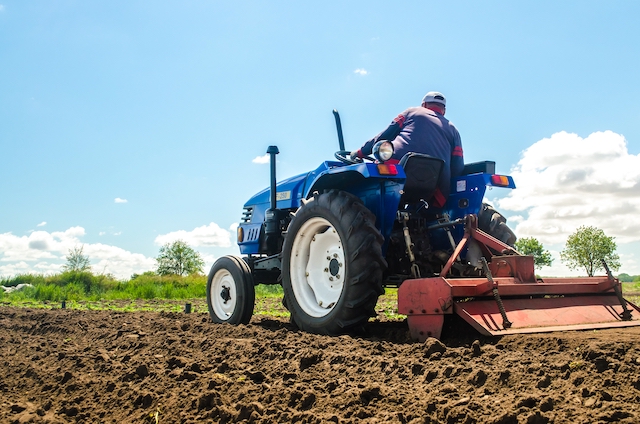
Objective of Tillage
- Improve soil aeration 🌬 for gaseous exchange in the seed and root zone.
(Primary Objective) - Adequate seed-soil contact to permit water flows to seed and seedling roots.
- A non-crust soil contact to permit seedling emergence.
- A low density soils that permit root elongation and proliferation.
- An environment that provides adequate light to the seedling (weed free environment).
- A pest and pathogen free environment.
- Mixing the applied manures and fertilizers with the soil, and
- Removing the hard pan, if any to increase the soil depth for water absorption.
👉🏻 The aim of the tillage is to produce as good a soil condition or tilth as possible for crop establishment and initial shoot and root development.
Seed Bed
When soil is brought to such a condition ideal for crop growth, it is called seed-bed and is said to be in good tilth. The ideal seed-bed is a soil in which porosity of the mineral solid matter provides an optimum balance between water holding and freely drained. The optimum balance appears to be the one in which capillary pores are in equal proportion.
Classification of Tillage Systems
- Based on Time (with respect to the crop): Preparatory cultivation and after cultivation
- Based on Season: On-season Tillage and Off-season Tillage
- Modern Concepts of Tillage: Conventional tillage and Conservation tillage
Preparatory Tillage
- This refers to tillage operations that are done to prepare the field for raising crops.
- It consists of deep opening and loosening of the soil to bring about a desirable tilth as well as to incorporate or uproot weeds and crop stubble when the soil is in a workable condition.
👉🏻 Types of Preparatory Tillage
- Primary Tillage
- Secondary Tillage
- Layout of seed bed
Primary Tillage
- The tillage operation that is done after the harvest of crop to bring the land under cultivation is known as primary tillage or ploughing.
- Ploughing is the opening of compact soil with the help of different ploughs.
- In addition, ploughing should ensure inversion (whenever necessary).
- Primary tillage operations are deep tillage, sub soil tillage, year round tillage etc.
Primary Tillage Implements
-
Country/Desi Plough
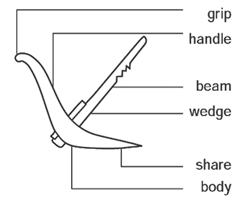
-
Mould Board Plough
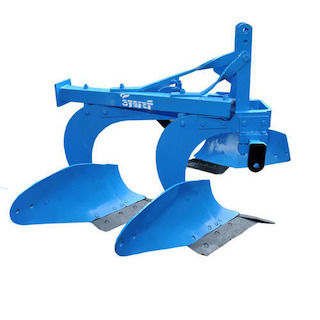
-
Bose Plough
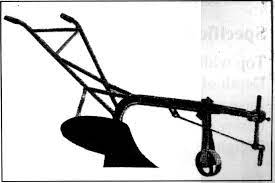
-
Ridge Plough

-
Disk Plough
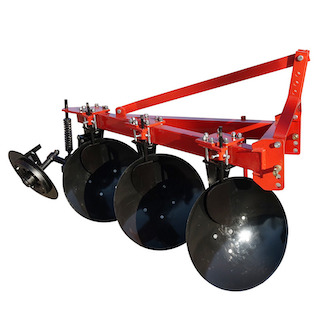
Secondary Tillage
- Lighter or finer operations performed on the soil 😳 after primary tillage to create a good seedbed for proper seeding/planking are known as secondary tillage. After ploughing the fields are left with large clods with some weeds and stubbles partially uprooted.
Harrowingis done to a shallow depth to crush the clods and to uproot the remaining weeds and stubbles.Plankingis done to crush the hard clods to smoothen the soil surface and to compact the soil lightly.- Thus, the field is made ready for sowing after ploughing by harrowing and planking.
- Generally sowing operations are also included in secondary tillage.
Secondary Tillage Implements
-
Disc Harrow
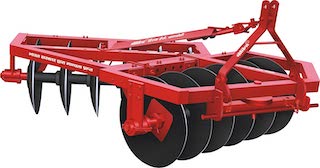
-
Blade Harrow

-
Spring Tooth Harrow
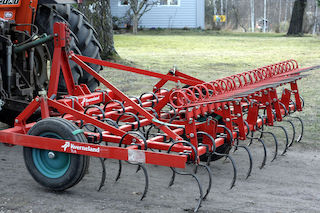
-
Cultivator

-
Planking
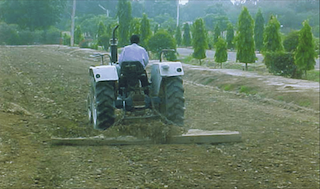
-
Roller

Layout of seed bed:
- After the seedbed preparation, the field is laid out properly for irrigation and sowing or planting seedlings.
- These operations are crop specific.
- For most of the crops like wheat, soybean, pearl millet, groundnut, castor etc., flat levelled seedbed is prepared.
- That is, after the secondary tillage, these crops are sown without any land treatments.
- For some crops like maize, vegetables etc., the field has to be laid out into ridges and furrows.
- Sugarcane is planted in the furrows or trenches.

Seed Drill
This consists of dropping the seeds in the furrow lines in a continuous flow and covering them with soils as this method is very helpful in achieving proper depth, spacing and amount of seed that need to be sown in the field.
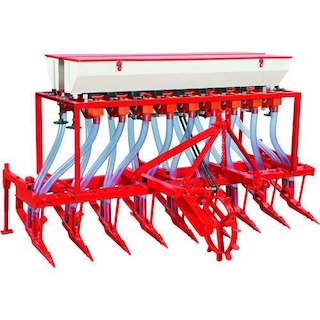
Seed drill was invented by Jethro Tull in 1701 as a way to plant more efficiently. Before this, sowing of seeds was done by hand, by scattering them on the ground or placing them in the ground individually, such as with bean and pea seeds. Tull considered scattering wasteful because many seeds did not take root.
After-Cultivation
- The tillage operations that are carried out in the standing crop are called after tillage.
- Collectively, the cultivation practices taken up after sowing of crop is called inter-cultivation.
- It otherwise called as after operation or
inter-culturing. - It facilitates good aeration, and better development of root system.
Blind cultivation– The cultivation after planting and before crop emergence.
Broadly, there are three Inter-cultivation practices:
- Thinning and Gap Filling
- Weeding & Hoeing
- Earthing up
Thinning and Gap Filling
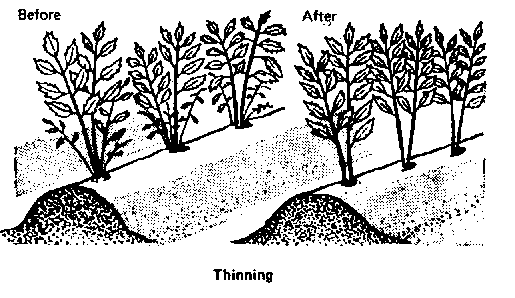
- The objective of thinning and gap filling process is
to maintain optimum plant population. - Thinning is the removal of excess plants, leaving healthy seedlings.
- Gap filling is done to fill the gaps by sowing of seeds or transplanting of seedlings in gap where early sown seed had not germinated.
- Both thinning and Gap Filling are simultaneous process.
- Normally, these are practiced a week after sowing to a maximum of 15 days. In dryland agriculture, gap filling is done first.
Weeding and Hoeing
- Weeding is the process of eliminating competition of unwanted plants to the regular crop in respect to nutrition and moisture. So that crops can be grown profitably. It also facilitates other operations like irrigation and fertilizer application.
- Both Weeding and Hoeing are simultaneous operation.
- Hoeing is disturbing the top soil by small hand tools which helps in aerating the soil.

Earthing-up

- It is the process of putting the earth or soil just near the base for certain crops like
Sugarcane, Cassava, Papaya,Potato, etc. to give support to the plants. - In Sugarcane, Papaya, Banana - To avoid lodging.
- In Cassava, Potato - To provide more soil volume for the growth of tubers.
- In Vegetables - To facilitate irrigation.
- It is carried out in wide spaced and deep-rooted crops.
- It is done around 6-8 weeks after sowing / planting in sugarcane, tapioca, banana, etc.
Lodging is the displacement of stems or roots from their vertical and proper placement. It can cause lower yields and diminish nutrient density.
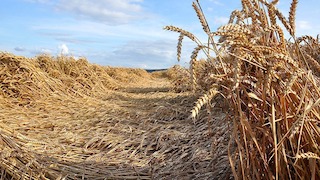
Other inter-cultivation practices
👉🏻 Harrowing
- Stirring or scraping the surface soil in inter and intra row spacing of the crop using tools or implements.
👉🏻 Roguing
- Removal of plants of a variety admixed with other variety of same crop.
👉🏻 Topping
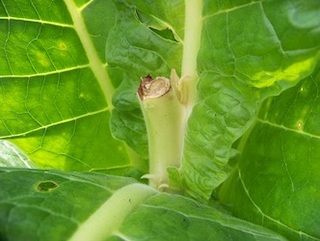
- Removal of terminal buds and flowers.
- It is done to stimulate auxiliary growth.
- Practiced in
cottonandtobacco. - As there is no requirement of terminal growth and flower in tobacco, we are only interested in leafy portion.
👉🏻 Propping
- The operation of tying the leaves together using the bottom dry and green leaves in sugarcane and giving support to pseudostem of banana is known as propping.
- Usually the trash without removing from the cane is twisted to form a sort of rope and cane stalks are tied together. It is primarily done to check lodging.
- It is generally practiced in
sugarcaneandbanana.
👉🏻 De-trashing
- Removing of older leaves from the
sugarcanecrop.
👉🏻 De-suckering
- Removal of auxiliary buds and branches which are considered non-essential for crop production and which removes plant nutrients considerably are called suckers. Eg.
Tobacco. - As this energy could be used for healthy leaf growth.
Classification of tillage based on Season
On-Season Tillage:
- Tillage operations that are done for raising crops in the same season or at the onset of the crop season are known as on-season tillage.
- They can be preparatory cultivation and after cultivation. (We have discussed these in the above section).
Off-Season Tillage:
- Tillage operations done for conditioning the soil suitably for the forthcoming main season crop are called off-season tillage.
- Off season tillage may be, post-harvest tillage, summer tillage, winter tillage and fallow tillage.
Modern Concepts of Tillage
Conventional Tillage
- Conventional tillage involves primary tillage to break open and turn the soil followed by secondary tillage to obtain seed bed for sowing or planting.
- With the introduction of herbicides in intensive farming systems, the concept of tillage has been changed (The important objective of tillage is weed control which can be done by herbicides).
- The depth of tillage has been reduced and cultivator replaced the plough as primary tillage implement, particularly on heavy soils.
- There has been an increasing trend to reduce the number of cultivations in order to avoid undesirable results of over cultivation.
- Reduction or elimination of tillage has been accompanied by direct drilling of seeds.
- The greatest success and potential for restricted tillage appear to be on heavy soils, where timely cultivation is so critical.
- The main disadvantages are that direct drilling favours proliferation of perennial weeds and certain pests and diseases. Nutrient leaching may be greater than on ploughed land. Response of direct drilled crops to fertilizers is lesser because of greater weed competition or slower crop establishment. Soil is invariably more compacted and proportion of large pores decreases.
- Continuous use of heavy ploughs creates
hard panin the subsoil, results in poor infiltration. - It is more susceptible to run-off and erosion. It is capital intensive and increase soil degradation.
- To avoid these ill effects, modern concepts on tillage such as minimum tillage, zero tillage and stubble mulch tillage/farming are in trend. These collectively can be referred to as Conservation tillage.
Conservation Tillage
A) Minimum Tillage
- Minimum tillage refers to growing a crop using only that tillage needed for placing the seed at proper depth and then covering them. Thus minimum tillage aimed that reducing tillage to the minimum necessary for ensuring a good seedbed, rapid germination, satisfactory stands and favourable growing condition.
- The concept of minimum tillage was started in
USA. - Minimum tillage or no-till system reduces the availability of potassium due to increased compaction, lessened reaction, lower temperature and positional availability.
- Tillage can be reduce in 2 ways:
- By omitting operations which do not give much benefits when compare to the cost, and
- By combining agricultural operations like seeding and tillage.
👉🏻 Advantages of Minimum Tillage
- Improves soil conditions due to decomposition of plant residues insitu.
- Improves soil physical condition due to incorporation of organic residues leading to higher water infiltration into the subsoil
- Higher infiltration is caused by the vegetation present on the soil and channels formed by the decomposition of dead roots.
- Less resistant to root growth due to improved soil structure.
- Lesser surface runoff of rain water.
- Satisfactory crop stand establishment.
- Less soil compaction by the reduced movement of heavy tillage vehicles and
less erosioncompare to conventional tillage.
👉🏻 Disadvantages of Minimum Tillage
- Seed germination is lower with minimum tillage.
- In minimum tillage, more nitrogen has to be added as the rate of decomposition of organic matter is slow.
- Nodulation is affected in some leguminous crop i.e. Field pea, Beans.
- Sowing operations are difficult with ordinary implements.
- Continuous use of herbicides causes pollution problem and dominance of perennial problematic weeds.
👉🏻 Methods of Practising Minimum Tillage
- Row zone tillage
- Plough plant tillage
- Wheel track planting
Row Zone Tillage
Row zone tillage means after primary tillage with MB plough, 2nd tillage operations like disking and harrowing are reduced. 2nd tillage is done in row zone only.
Plough Plant Tillage
After the soil is ploughed, a special planter is used and run over the field. The row zones is pulverized and seeds sown.
Wheel Track Planting
Ploughing is done as usual. Tractor is used for sowing and the wheels of tractor pulverizes the row zone.
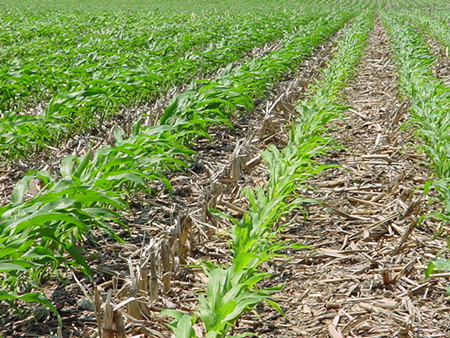
B) Zero Tillage
- Zero tillage referred as
no tillagein which the crop is planted in unprepared soil by opening a narrow slot, trench or band only of sufficient width and depth to obtain proper seed coverage. The weeds are controlled only by chemical means. 🧪 - The word ‘Zero tillage’ was given by
Jethrotull. USAis the 1st country to introduce zero tillage.- Zero tillage is possible where the soil has:
- Course textured surface,
- Good internal drainage and
- Adequate quantity of residue as mulch.
- Problems of zero tillage are low seed germination, low mineralization and buildup of volunteer plants.
- Commonly
contact herbicidesare used under zero tillage likeparaquateanddiquat.
🧐 What is/are the advantage/advantages of zero tillage in agriculture? 🏆 UPSC Pre 2020
1. Sowing of wheat is possible without burning the residue of previous crop.
2. Without the need for nursery of rice saplings, direct planting of paddy seeds in the wet soil is possible.
3. Carbon sequestration in the soil is possible.
Select the correct answer using the code given below:
(a) 1 and 2 only
(b) 2 and 3 only
(c) 3 only
(d) 1, 2 and 3
Answer: d
Tillage System
With 30 percent or more crop residue left after planting
Conservation Tillage
- Conservation tillage is a system of tillage in which organic residues are not inverted into the soil such that they remain on the surface as a protective cover against erosion and evaporational losses of soil moisture.
- If stubbles form the protective cover on surface, it is usually referred as
stubble mulch tillage. - The residues left on the soil surface interfere with seed-bed preparation and sowing operations.
- Conservation tillage is also known as
Eco-fallow🌿.
Any tillage and planting system that covers 30 percent or more of the soil surface with crop residue, after planting, to reduce soil erosion by water or any system that maintains at least 1,120 kilograms per hectare of flat, small grain residue equivalent on the surface throughout the critical wind erosion period is called conservation tillage system.
👉🏻 Conservation tillage system are further classified:
- No-till No-till is defined as a system in which the soil is left undisturbed form harvest to planting except for nutrient injection.
- Ridge-till Plating is completed in a seedbed prepared on ridges with sweeps, disk openers, coulters or row cleaners.
- Mulch-till The soil is disturbed before planting. Mulch-till is a category that includes all conservations tillage practices other than no-till and ridge-till. Two tillage practices that fall into this category are zone-till and strip-till.
- Minimum Tillage
Less than 30 per cent crop residue left after plating
Reduced Tillage
Reduced-till systems leave 15-30 percent residue cover after planting or 560 to 1,120 kilograms per hectare of small grain residue equivalent throughout the critical wind erosion period.
Conventional Tillage
Conventional-till systems leave less than 15 percent residue cover after planting, or less than 560 kilograms per hectare of small grain residue equivalent throughout the critical wind erosion period. These systems generally involve ploughing or some other form of intensive tillage.
👉🏻 Clean tillage means working of the soil of entire field in a way that no living plant is left undisturbed. (IBPS 2018)
👉🏻 Puddling is ploughing the land with 5-10 cm standing water with an objective to create an impervious layer below the surface to reduce deep percolation losses of water and to provide soft seedbed for planting rice. NABARD 2021
Depth of Tillage
One cmof surface soil overone haof land weight about of150 tonnes. Therefore, to plough deeper, enormous amount of energy is required.- CRIDA (Central Research Institute for Dryland Agriculture), Hyderabad has classified:
- Shallow Tillage – when soil is tilled up to depth of
5 cm to 6 cm. - Medium Depth Tillage – soil tilled from the depth of
15-20 cm - Deep Tillage - when soil is tilled up to depth of
25 cm to 30 cm, generally carried out in root crops.
Deep ploughing when done in summer turns out large sized clods, baked by the hot sun. These clods crumble due its alternate heating and cooling due to occasional summer showers. This process of gradual disintegration of clods improves soil structure. The rhizomes and tubers of problematic weeds like cynodon dactylon, Cyprus rotundus die due to exposure to the sun. It also kills insect and pests.
Germination 🌱
- Temperature: When it is above and below the optimum temperature, the germination rate will be affected.
- Light: The most effective wavelength for promoting germination is
red (662 nm)and 730 nm inhibits germination. - Small seed requires fine tilth whereas moderate and large seeds requires medium and coarse tilth soil respectively.
- The thumb rule 👍🏻 is to sow seeds to a depth of approximately
3 to 4 times the diameter of the seed. - The optimum depth of sowing for most of crops is
3 to 5 cmdepth.
Optimum Plant Population 🌾
👉🏻 Plant population is defined as the total number of plants present in unit area of land.
- Optimum plant population is the number of plants required to produce maximum output or biomass per unit area.
- Under high plant population, individual plant yield will be low due to narrow spacing leading to competition between plants.
- Yield per plant decreases gradually as plant population per unit area is increased but yield per unit area increases up to certain level of population. That level of plant population is called as optimum population.

Factors affecting plant population:
Genetic Factors
Size of the plant
The volume occupied by the plant at the time of flowering decides the spacing of the crop. Plants of red gram, cotton, sugarcane etc. occupy larger volume of space in the field compared to rice and wheat.
Elasticity of the plant
- Variation in size of the plant between minimum size of the plant that can produce some economic yield to the maximum size of the plant that can reach under unlimited space and resources.
- The optimum plant population range is high in indeterminate plants. Eg. Red gram: 55,000 to 1,33,000 plants/ha.
- The elasticity is due to tillering and branching habit of the plants.
- For determinate (limited branching) plants like pearl millet, sorghum elasticity range is less.
- For indeterminate (unlimited branching) plants like cotton and Red gram, more branches will be produced by the crop.
Foraging area or soil cover
- Crop should cover the soil as early as possible so as to intercept maximum sunlight.
- Higher the intercepted radiation more will be the dry matter produced.
Dry matter partitioning
- Dry matter production is related to amount of solar radiation intercepted by the canopy which depends on plant density.
- As the plant density increases, the canopy expands more rapidly, more radiation is intercepted, and more dry matter is produced.
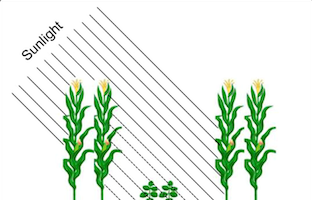
Crop and variety
- Depending on the crops and varieties, the plant population varies.
Rice:
- Plant population = Area / Spacing
- Rice (Short duration) spacing 15cm x 10cm, Area= 1ha= 10000 sq-meters
- Plant Population: 10000/0.15x0.10
- PP = 6,66,666 Plants/ha Other Examples:
- Medium duration rice: 5,00,000 plants/ha (20 cm x 10 cm)
- Long duration rice: 3,33,000 plants/ha (20 cm x 15 cm)
Cotton:
- BT -
10,000 plants/ha(100 cm x 100 cm) - Hybrid - 67,000 plants/ha (100 cm x 60 cm)
- Desi Cotton: 1,11,111 plants/ha (60 cm x 15 cm)
Maize:
- 83,333 plants/ha (60 x 20 cm)
- Hybrids: 47,620 plants/ha (60 x 35 cm)
Environmental factors
- Time of sowing: Generally early and late sowings are associated with lower plant population. Beacuse of mortality of seedling in such conditions.
- Rainfall / irrigation: Generally plant population is higher in irrigated condition.
- Fertilizer application: Higher the fertilizer application rate, higher the plant population.
- Seed rate: Higher the seed rate, higher the plant population.
Plant Geometry
The arrangement of the plants in different rows and columns in an area to utilize the natural resources efficiently is called crop geometry. It is otherwise area occupied by a single plant Eg. Rice – 20 cm x 15 cm.
Types of Plant Geometry
- Random Plant Geometry
- Square Plant Geometry
- Rectangular method of sowing
- Triangular method of sowing
- Quincunx or Diamond pattern
Random Plant Geometry
- Random plant geometry results due to
broadcasting methodof sowing and no equal space is maintained. - Resources are either underutilized or over exploited.
Square Plant Geometry
- The plants are sown at equal distances on either side. Mostly perennial crops, tree crops follow square method of cultivation.
- Ex. Coconut – 7.5 x 7.5 m; banana – 1.8 x 1.8 m. But, due to scientific invention, the square geometry concept is expanded to close spaced field crops like rice too.
✅ Advantages
Light is uniformly available, movement of wind is not blocked, and mechanization can be possible.
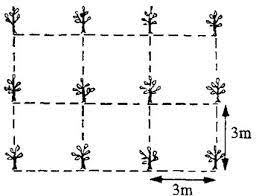
Rectangular Method of Sowing
There are rows and columns, the row spacing are wider than the spacing between plants.
The different types exist in rectangular method are:
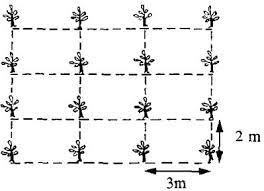
Solid Row
Each row will have no proper spacing between the plants. This is followed only for annual crops which have tilling pattern. There is definite row arrangement but no column arrangement, Ex. Wheat.

Skip Row
A row of planting is skipped and hence there is a reduction in population. This reduction is compensated by planting an intercrop; practiced in rain-fed or dry-land agriculture.

Triangular Method of Planting
It is recommended for wide spaced crops like coconut, mango etc. The number of plants per unit area is more in this system.
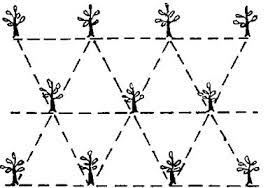
Quincunx or Diamond Pattern of Planting
- The quincunx or diamond pattern of arranging row-planted crops is a
modified form of the square pattern. - It consists of a square that is formed by 4 closest plants with an additional plant at the center of these 4 plants.
- The 4 plants that form a square are the main crops while the crop at the center is called a
filler crop.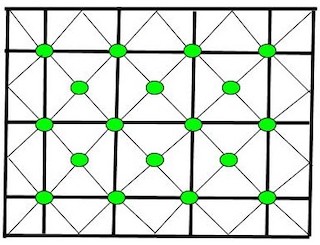
Paired Row Arrangement
The paired row arrangement can be seen both in the Square and Rectangular plant geometry type.
In some cases, we observe this in triangular method of plant geometry as well.
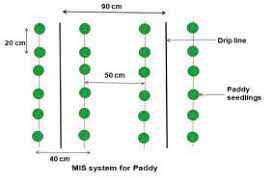
- In paired row plantation with squared geometry, plant to plant spacing (Z) is same as that of row (X) to spacing while in paired row plantation with rectangular geometry the plant to plant spacing (Z) is more than the row to row spacing (X).
- In both the geometries one lateral is provided at the middle of the two crop rows such that two rows are equally spaced from the lateral.
- Dimension Y is the distance between two paired rows. Some features:
- The number of rows per hectare remains the same.
- The advantages are that wide spacing is available between the any two sets of paired rows which can be utilized for growing profitable intercrops.
Recommended Planting Geometry (Spacing of Field Crops)
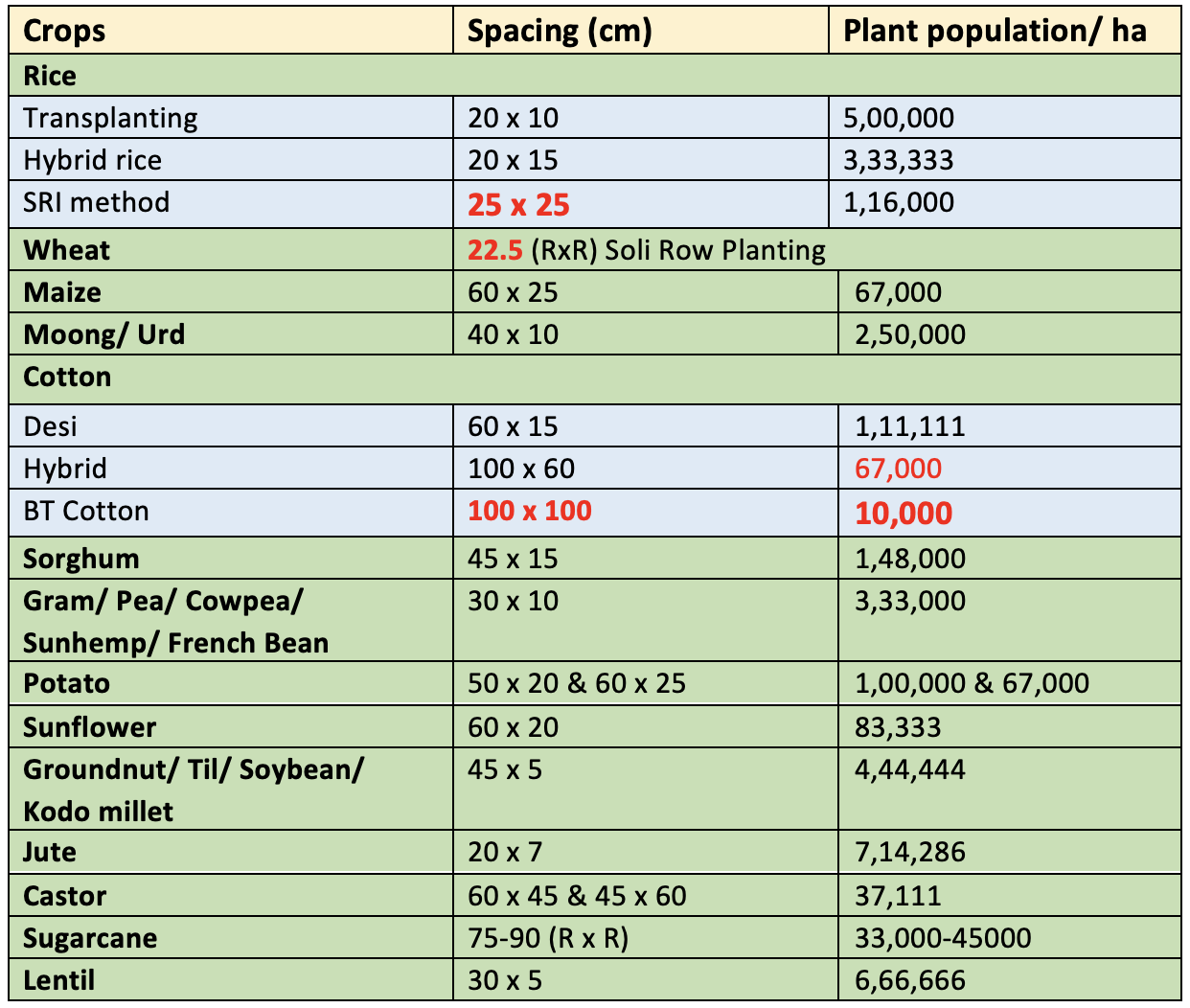
What is Tillage? ⛏
- The word tillage is derived from the Anglo-Saxon words tilian and teolian, means to plough and prepare soil for good seed to sow, to cultivate and raise crops.
- “Tillage is the mechanical manipulation of the soil for obtaining conditions ideal for seed germination, seedling establishment and growth of crops”.
- Note:
Jethrotullis considered as Father of Tillage.
Tilth
- Tilth is the
physical condition of soilobtained out of tillage (or) it is the result of tillage. - Due to tillage in soil, Bulk density of soil
decreases. - Good tilth has
0-5 mmsize of aggregates. - More than 5 mm (> 5mm) soil aggregate size must be required for good crop under irrigated conditions.
- The proportion of
50:50 (1:1) of capillary and non-capillary poresis must for good crop production. …
Become Successful With AgriDots
Learn the essential skills for getting a seat in the Exam with
🦄 You are a pro member!
Only use this page if purchasing a gift or enterprise account
Plan
- Unlimited access to PRO courses
- Quizzes with hand-picked meme prizes
- Invite to private Discord chat
- Free Sticker emailed
Lifetime
- All PRO-tier benefits
- Single payment, lifetime access
- 4,200 bonus xp points
- Next Level
T-shirt shipped worldwide

Yo! You just found a 20% discount using 👉 EASTEREGG

High-quality fitted cotton shirt produced by Next Level Apparel